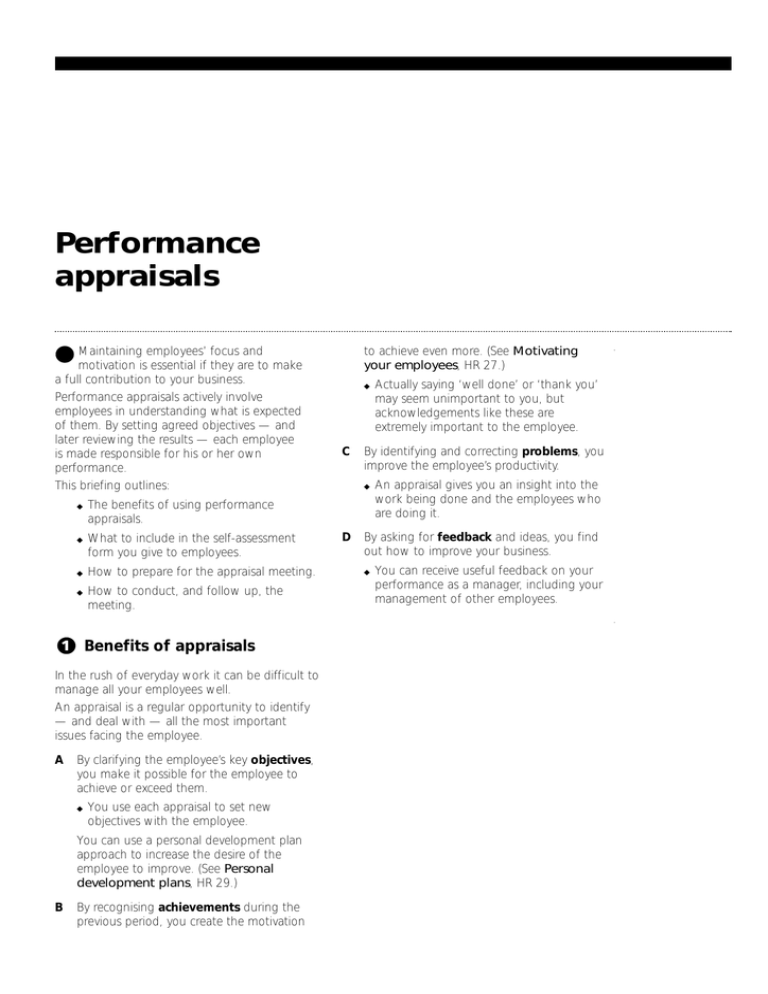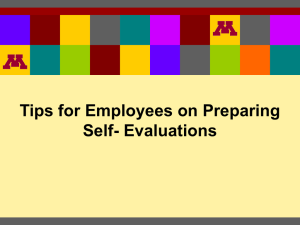Performance appraisals
advertisement

Performance appraisals Maintaining employees’ focus and motivation is essential if they are to make a full contribution to your business. Performance appraisals actively involve employees in understanding what is expected of them. By setting agreed objectives — and later reviewing the results — each employee is made responsible for his or her own performance. This briefing outlines: ◆ The benefits of using performance appraisals. ◆ What to include in the self-assessment form you give to employees. ◆ How to prepare for the appraisal meeting. ◆ How to conduct, and follow up, the meeting. Benefits of appraisals In the rush of everyday work it can be difficult to manage all your employees well. An appraisal is a regular opportunity to identify — and deal with — all the most important issues facing the employee. A By clarifying the employee’s key objectives, you make it possible for the employee to achieve or exceed them. ◆ You use each appraisal to set new objectives with the employee. You can use a personal development plan approach to increase the desire of the employee to improve. (See Personal development plans, HR 29.) B By recognising achievements during the previous period, you create the motivation to achieve even more. (See Motivating your employees, HR 27.) ◆ C Actually saying ‘well done’ or ‘thank you’ may seem unimportant to you, but acknowledgements like these are extremely important to the employee. By identifying and correcting problems, you improve the employee’s productivity. ◆ An appraisal gives you an insight into the work being done and the employees who are doing it. D By asking for feedback and ideas, you find out how to improve your business. ◆ You can receive useful feedback on your performance as a manager, including your management of other employees. Appraisals show your employees you care about their problems, their aspirations and their views. Done well, appraisals result in employees being confident and focused on their objectives. Self-assessment questionnaire Let the employee know well in advance when the performance appraisal will be. Ask the employee to complete a self-assessment questionnaire for you as part of the preparation. Different levels and types of employee may need different questionnaires. But all the questionnaires should include open questions such as the ones below. B C What were your key objectives (see 5) and did you achieve them? ◆ What problems did you encounter? ◆ What did you do really well? ◆ In which areas do you think you could improve your performance? Appraising under-performers Carrying out an appraisal of an employee who is under-performing requires particular skill. ◆ ◆ ◆ ◆ ◆ ◆ Tackle problems as and when they arise, rather than waiting for an appraisal. The appraisal is then a review of known problem areas. Confirm what the minimum targets and standards are that the employee should be reaching. These will have been set at the previous appraisal, or earlier. Compare the employee’s performance with these targets and standards, which must be measurable. Provide specific examples and evidence of under-performance. Focusing on performance makes heavy criticism (if necessary) much easier, and helps you avoid personality issues. Be supportive, constructive and fair. Look at the problems from the employee’s perspective. If you are in a disciplinary situation, follow the correct disciplinary procedures to avoid possible litigation by the employee. (See Discipline and grievance issues, HR 18.) Continual monitoring of the employee after the appraisal is crucial, to secure the improvements that were agreed. ◆ What are your strengths and weaknesses? ◆ Are you well organised? ◆ Can you work on your own initiative? Are you a team worker? ◆ How well do you get on with others in your team? ◆ How well do you get on with others in the company? D How is your attitude to work? A How well have you performed since your last review? ◆ How would you rate your own skills? E ◆ What do you find most or least interesting in your job? ◆ Do you have any interests or abilities which could be better used? ◆ How flexible are you? ◆ How punctual, reliable and committed are you? What do you think your key objectives for the next six months should be? ◆ What help and training do you need? (See Using training effectively, HR 28.) Use questions which are easy to understand. Make the purpose of the review clear (eg that it is not a pay review, which is a separate issue). Manager’s preparation You should prepare a plan for the appraisal meeting. A Review the employee’s completed self-assessment questionnaire. ◆ B Review the performance appraisal report which was written following the previous appraisal (see 6). ◆ C Identify the important issues and focus the appraisal on them. Note which objectives have — and have not — been achieved. Think about the big picture, as well as operational issues. ◆ For example, the career opportunities (or training opportunities) that are open to the employee. D Work out your objectives for the appraisal. ◆ For example, if there is no opportunity for promotion, your goal may be to maintain the employee’s commitment and motivation. ◆ Deal with any recent one-off problems before the appraisal. page 2 E Have examples (or other evidence) ready to back up the points you wish to make. ◆ For example, if you are concerned that a salesman is neglecting certain customers, and the information is readily available, check when the salesman’s customers were last contacted. This shows the employee that your concern is a reasonable one. F implement a solution that he or she has helped work out. ◆ E Write down your meeting plan for the appraisal (see 4). Review the employee’s long-term career plans, if these have changed. ◆ The less you have worked directly with the employee, the more effort you need to put into the preparation stage. For example, you may need to seek feedback on the employee from other people. F The appraisal meeting Appraisals should allow employee and manager to express their views freely and frankly. (See Assertiveness, HR 30.) The eight steps outlined below should help you achieve this. A Explain the agenda (your plan) for the meeting, and what you hope to achieve. B ◆ Put the employee at his or her ease. ◆ Start on a positive note by praising the employee’s work in general. Ask the employee to talk you through the self-assessment (see 2), focusing on the areas which you have identified as being the most important — typically the key objectives. ◆ C Employees tend to be over-critical of their own performance. They also identify problems you were not even aware of. This makes your role much easier. You can focus on helping the employee to find the solutions, rather than having to point out all the weaknesses and problems. Take every opportunity to acknowledge achievements and hard work. ◆ Be clear about which areas of performance need improvement. D Discuss the problem areas and come up with solutions together. ◆ Ask the employee to explain why the problem has occurred. Then ask the employee to suggest a solution, which may match your own ideas. The employee is far more likely to This may unearth new problems or opportunities. For example, you may realise that the employee is looking for another job — in which case you need to either persuade him or her to stay, or make plans for what will happen when the employee goes. Consider the employee’s training needs. ◆ Typically this will be one-to-one on the job training. ◆ Also review the value of any previous training. G Discuss and agree a new set of key objectives for the next period (see 5). ◆ Decide when the next appraisal — or interim meeting — will be. H Discuss any ideas for improving the effectiveness of the performance appraisal process. ◆ The employee may feel that the process has been unfair in some way. Aim to spend twice as much time listening to the employee as you do talking. Much of the skill of doing effective appraisals lies in your questioning technique. If you ask ‘open’ questions (eg ‘what do you think about...?’), and show genuine interest, most employees will be happy to talk at length. See Communicating with employees, HR 32. Setting key objectives Add your own views about the employee’s performance. ◆ Look beyond the symptoms to the root of the problem. For example, a problem might stem from lack of confidence, lack of training, or something not even related to work. The whole appraisal cycle is built around setting, reviewing and then re-setting key objectives. A Each objective should be SMART — specific, measurable, agreed, realistic and timelimited. ◆ Each objective must be in an area over which the employee has control. ◆ Give each objective a deadline. ◆ A clear target allows you to measure whether the employee is making the progress you expect. page 3 ‘To be a good salesman’ fails the SMART test in every way. But, if it was realistic, ‘to add at least five new customers by the end of the year’ might be a suitable objective. B Many elements of the job may already be covered by set standards (see Everyday workplace policies, HR 16). manager) to review. ◆ D There should be an appeals procedure in place, for employees who feel that any part of the appraisal process has been unfair. ◆ For example: ◆ In an office, you may have standards for answering the phone (within four rings) or handling sales queries (within 24 hours). ◆ In a warehouse, you might have standards for attendance, breakages and safety. ◆ On a production line, you might have standards for output per hour, wastage and machine down-time. For many blue collar employees, much of the appraisal will be focused on reviewing the achievement of standards. For example, the driver of a delivery van might be reviewed primarily in terms of reliability, promptness and breakages. E Involve the employee in setting objectives. The employee usually knows the job, and its constraints, better than you. Following up A Immediately after the meeting, write up the performance appraisal report. This summarises what has been discussed and agreed, including: B ◆ Monitor the employee’s progress towards the objectives that have been set. ◆ Keep using the supportive, collaborative approach that you used for the appraisal. B ◆ If your appraisal system is ineffective, it is probably due to the poor skills of the managers conducting the appraisals. ◆ Train your managers in appraisal skills. ◆ Train your employees in appraisee skills, so that they can contribute effectively. Bottom-up appraisal is a more comprehensive approach. ◆ C Each employee is appraised by subordinates, as well as a line manager. A 360-degree appraisal is more thorough still, taking in feedback from subordinates, colleagues, superiors, and customers. ◆ One advantage of this approach is that the appraisal is less vulnerable to bias. ◆ A disadvantage is the sheer amount of time the process consumes. D The optimum frequency of appraisals depends entirely on the circumstances. ◆ The objectives set for the next period. ◆ Any commitments you or the employee may have made. For example, you might have offered to train the employee in a particular task. ◆ If you are trying to motivate a team and drive the business forward, quarterly appraisals may be more appropriate. The report may include numerical scores for various categories of activity. ◆ An employee who is new, or has moved into a new role, may need quarterly appraisals. ◆ Another employee, who has done a routine job for several years, may only need one appraisal a year. At the very least, they should be once a year. Give the employee his or her own copy. ◆ C Performance management of the employee is an ongoing process for you. A It is common practice for employees to be reviewed by their line managers. Otherwise there is a danger the objectives will be unattainable, or simply ignored. ◆ For example, the whole matter might be reviewed by a personnel manager. Who appraises who, when? All the general points about appraisals still apply. A van driver needs support and motivation — and has potentially valuable feedback and ideas — like every employee. C If several managers in your business conduct appraisals, this is a vital check for fairness and consistency. There should be no surprises. Check that the employee agrees that what you have said is true and fair. Give a copy to your own line manager or another third party (such as the personnel The danger of undertaking too many appraisals is that they are then not done properly. page 4





